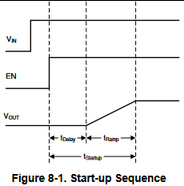Other Parts Discussed in Thread: TPS62865
Hi Team,
Can you help me understand how Start-up sequence and setting up VOUT works?

The datasheet states that, during start-up, the device sets the internal reference voltage, and determines the start-up output voltage through the resistor connected to the VSET/VID pin. Then during the ramp-up period, the output voltage ramps to the start-up output voltage first, then ramps up or down to the new value when the value of the output register is changed by I2C interface commands.
If I'm not using I2C, will the Vout be maintained by the VSET/VID’s resistor?
For example, if I wanted an output of 0.3V~ 0.5V, during start-up period, a resistor=133Kohm is connected to VSET/VID, then Vout= 0.5*1.00V =0.5V. Correct?

Then after start up, VSET/VID: resistor=133Kohm to GND. Vout is still =0 .5V?
Then If I were to DVS to change the output to 0.3V, how can I do this without I2C? I understand that the VID pin must be at 0.84V for H and 0.4V for Low to switch register but I don't understand Table 8-6 and Table 8-7. Can you help?
Great thanks!
Regards,
Marvin

